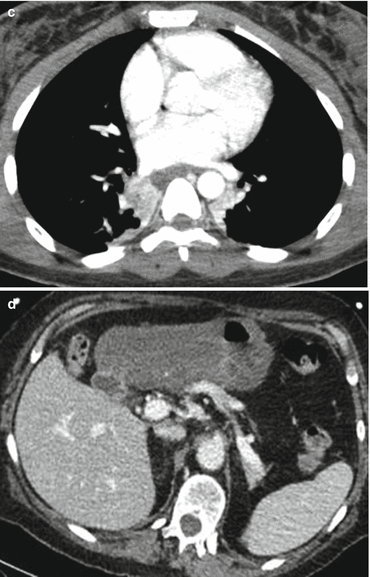
Fig. 26.1
Findings by computed tomography (CT). (a, b) Absence of transmural necrosis of the esophagus (a) and of the stomach (b). Post-contrast enhancement of the esophagus and the stomach is obvious (arrows) and the patient underwent successful nonoperative treatment. (c, d) Patient with transmural necrosis of the esophagus (c) (absence of esophageal enhancement, blurring of the esophageal wall and periesophageal fat) and the stomach (d) (absence of gastric wall enhancement); the pathology report confirmed transmural necrosis of the esophagus and the stomach

Fig. 26.2
Management algorithm for caustic injuries of the upper gastrointestinal tract
26.5.4 Nonoperative Management
A nonoperative approach can be offered to 70–80 % of patients after caustic ingestion. Patients eligible for nonoperative treatment may resume oral alimentation as soon they can swallow. After control of the psychiatric condition, patients with minor digestive tract involvement can be discharged as soon as they eat normally. Patients with severe injuries require close ICU monitoring immediately after ingestion; clinical and/or laboratory test aggravation (abdominal pain, rebound tenderness, shock, need for ventilatory support, renal failure, peripheral-blood leukocytosis, and/or acidosis) should prompt repeat evaluation (CT, endoscopy) to reassess the need for surgery.
26.5.5 Emergency Surgery
Emergency surgery is required in a small number of patients with full-thickness wall necrosis. In a recent report, emergency surgery was undertaken in 24 (20 %) of 120 consecutive patients managed with a combined CT-endoscopy algorithm [14]. Fiberoptic bronchoscopy should be performed on a systematic basis before surgery to rule out airway involvement. Laparotomy is the mainstay approach but laparoscopic exploration is feasible and safe [15]. The main emergency operations performed for the treatment of caustic injuries are detailed below.
26.5.5.1 Oesophagogastrectomy (OGT)
OGT is the most frequently employed procedure; it is indicated when evaluation (CT/endoscopy) suggests transmural esophageal necrosis and laparotomy confirms transmural gastric necrosis. OGT is performed through a combined abdominal and cervical approach using an esophageal stripping technique. A cervicostoma and a jejunostomy are constructed at the end of the operation to avoid enteral nutrition while waiting for reconstruction [1]. Esophagectomy with gastric preservation is performed in the unusual situation of transmural necrosis confined to the esophagus; the operative technique and outcomes are similar to the OGT procedure. Positioning of a gastrostomy tube is recommended to avoid postoperative distension of the stomach.
26.5.5.2 Total Gastrectomy
Necrosis confined to the stomach should prompt total gastrectomy; partial gastric resections should be avoided because ongoing necrosis might compromise outcomes. Immediate reconstruction by esophagojejunostomy (EJ) should be attempted if patient condition allows; esophageal exclusion or external drainage can be performed as a damage control strategy [16]. EJ leakage in this setting (5–8 %) is in the range of EJ failure rates reported after gastrectomy for cancer. Feeding jejunostomy should be constructed systematically as esophageal strictures develop in most patients.
26.5.5.3 Extended Resections
Extended resections (beyond esophagogastrectomy) are required when caustic necrosis involves other abdominal organs [17]. Concomitant resection of the spleen, the colon, the bowel, and of the duodeno-pancreas was reported in up to 20 % of patients who underwent OGT [1]. Necrosis of the transverse colon is usually due to the direct extension of posterior gastric wall injuries to the mesocolon. Transmural duodenal necrosis is usually managed by pancreatoduodenectomy (PD), although the pancreatic parenchyma is seldom involved. If the patient condition allows, immediate pancreato-biliary reconstruction is recommended [18]. Bowel necrosis is usually related to intraluminal passage of caustic agent; massive bowel necrosis contraindicates resection because of poor patient survival and compromised nutritional and reconstructive issues. All obvious transmural necrosis injuries should be resected during the initial procedure; second-look procedures should be reserved to rare situations when ongoing necrosis is suspected [17].
26.5.5.4 Tracheobronchial Necrosis (TBN)
On rare occasions, esophageal necrosis may extend directly to the posterior aspect of the tracheobronchial tree. If TBN is certified, esophagectomy should be performed by a right thoracic approach to avoid further injuries and allow airway repair with a pulmonary patch technique [19].
26.5.5.5 Outcomes of Surgery for Caustic Ingestion
Immediate outcomes of surgery for caustic injuries are mainly conditioned by the extent of surgery. In a recent publication, mortality rates of gastrectomy, OGT, PD, and TBN for caustic injuries were 11 %, 14 %, 39 %, and 45 %, respectively; morbidity rates were 63 %, 65 %, 94 %, and 100 %, respectively [1]. The standardized mortality ratio (SMR) after emergency surgery for caustic injuries was 21.5 when compared with the general French population [1]. During follow-up, the ongoing decline in survival persists far beyond the emergency period. Roughly half of the patients die within 10 years of surgery because of operative complications, malnutrition, late morbidity, deterioration of the psychiatric condition, and suicide. After emergency surgery, only half of the patients eventually regain nutritional and respiratory autonomy. Factors with negative impact on long-term survival and functional outcomes include advanced age and the extent of the initial insult (as reflected by extended resection, emergency tracheotomy, and tracheal necrosis) [1].
Stay updated, free articles. Join our Telegram channel

Full access? Get Clinical Tree







